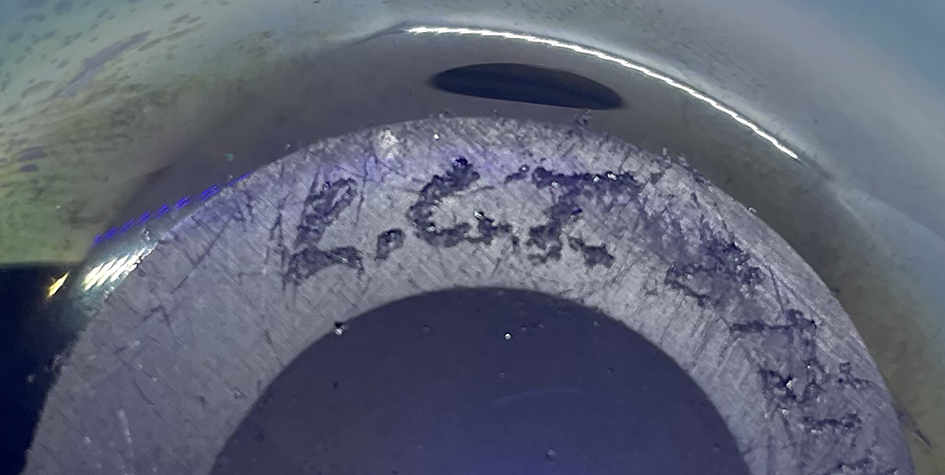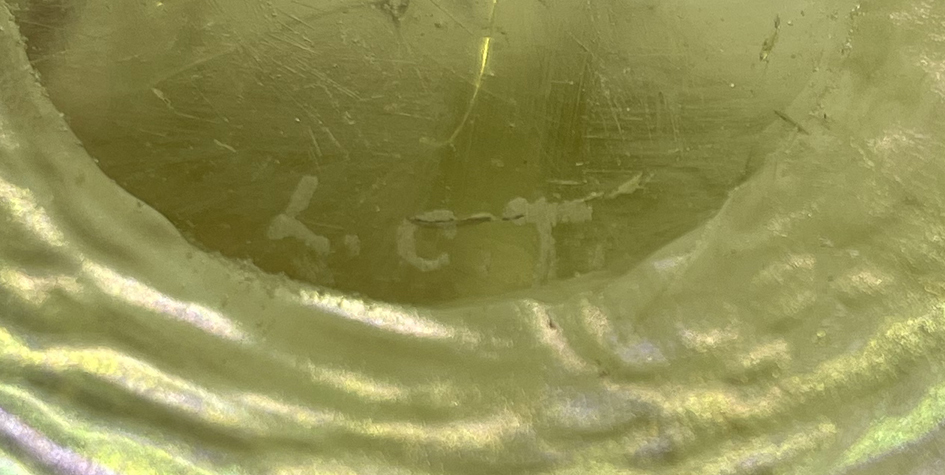Fake Tiffany glass? Real Tiffany glass? A little while ago, I picked up this delightful small iridescent art glass vase in an antiques store in Atlanta, Georgia. I’ve always been a fan of American Arts & Crafts iridescent glass and, at $70 (£52), it was within my budget.
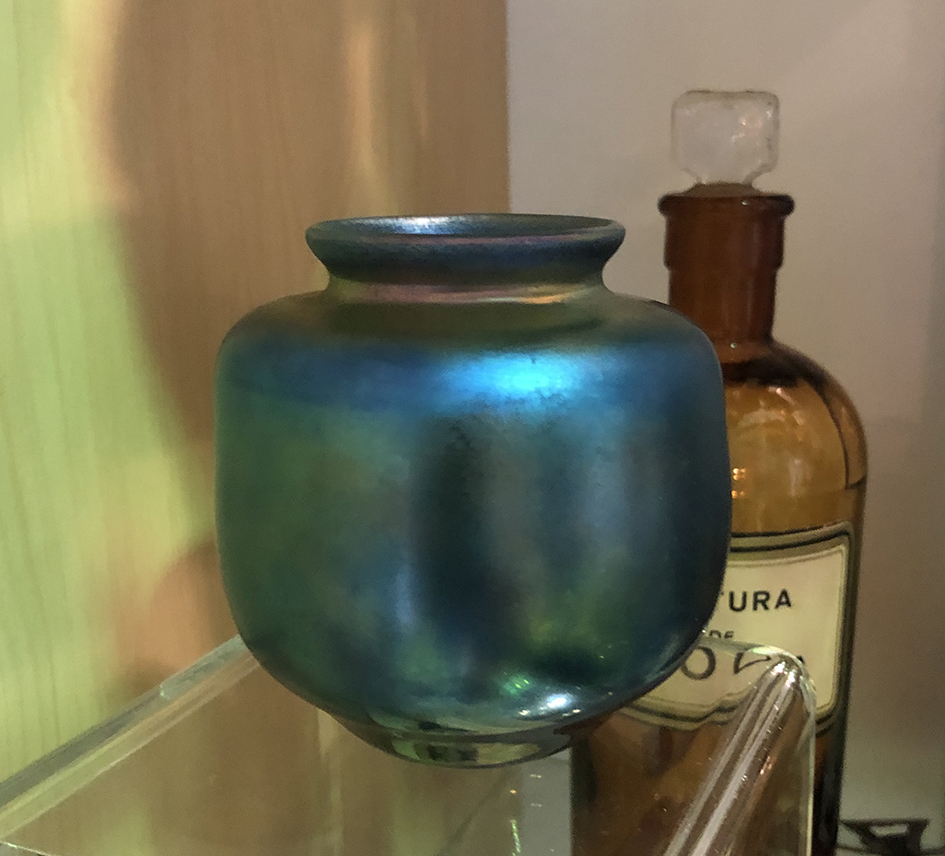
Turning it over, I was delighted to see the L.C.T. initials engraved into the base. They stand for Louis Comfort Tiffany (1848-1933), the legendary name in American art glass. Amongst other things, Tiffany was renowned for his iridescent Favrile glass, patented in 1894 and inspired by the effects on unearthed Ancient Roman and Syrian glass he had seen in the V&A museum. However, as I stood holding it in the shop, I smiled to myself as all was not what it seemed. Here’s why…
The Marks
Although the L.C.T. marks appear correct at first glance, the way they are engraved into the glass is not right. Both the tool used and the style of the letters are wrong. They’re also a bit clumsy. Although there are many different styles of authentic L.C.T. marks, comparing the letters to authentic marks on a Tiffany decanter in my collection shows this clearly. However, the scratches and wear go through the letters, so the L.C.T. must have been put on some time ago. But back to scratches later…
The Iridescence
Tiffany’s innovative Favrile glass was made by adding metallic oxides to the molten glass so that it actually became part of the glass and created a soft, deep, luxuriant and lustrous iridescence with a range of colours. Most other companies created iridescent effects by spraying oxides like stannous oxide onto the surface of the piece. Carnival Glass is a good example. Although lovely, the iridescence on my vase doesn’t quite have the ‘je ne sais quoi‘ of quality of Favrile iridescence. Also, looking at the entire body showed patches where the iridescence was spotty and ‘less’, as if it had been sprayed on and accidentally brushed off. That wouldn’t happen with Tiffany’s Favrile glass.
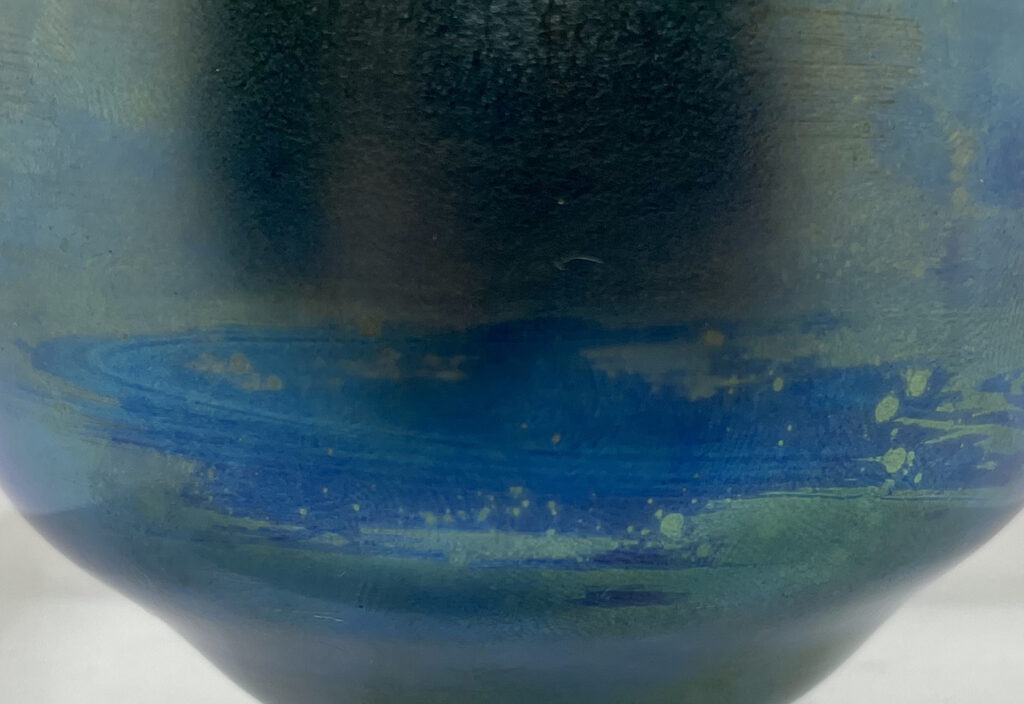
The Colour
Blue iridescent Favrile was produced by Tiffany. But Tiffany’s base glass also has a colour, which you can see by holding a piece up to a strong light and looking inside the piece. This glass is a strong light blue. Not an issue, but neither is it an indication that it’s by Tiffany.
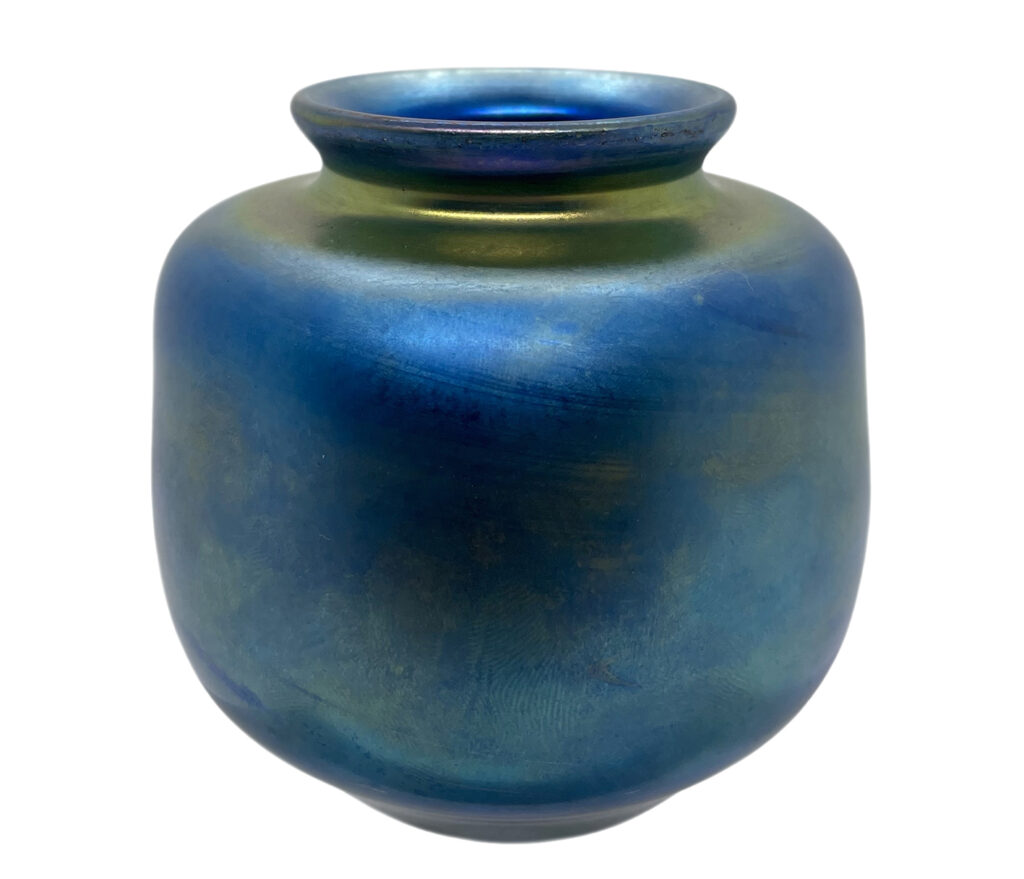
The Shape & Model Number
The body was hand blown and hand made, rather than being pressed or mould-blown by machine, and has a concave polished pontil mark. So far, so good. A search through Tiffany’s oeuvre of forms will reveal that this shape, with its short foot and flared rim, isn’t one of them. It’s also slightly more linear than I’d hope for with Tiffany. Although expected on Tiffany Favrile, the model number (8731) engraved near the initials didn’t match up with any Tiffany model number. And there’s no date letter.
Net Result? It wasn’t made by Tiffany.
So Who Made it Then?
Given the wear on the base, the weight, the shape, the glass thickness and other factors, I have no reason to doubt that it’s an authentic antique example of iridescent glass, and not a later 20th century example made by a studio glass maker. But who made it? Let’s go back to the scratches on the base again.
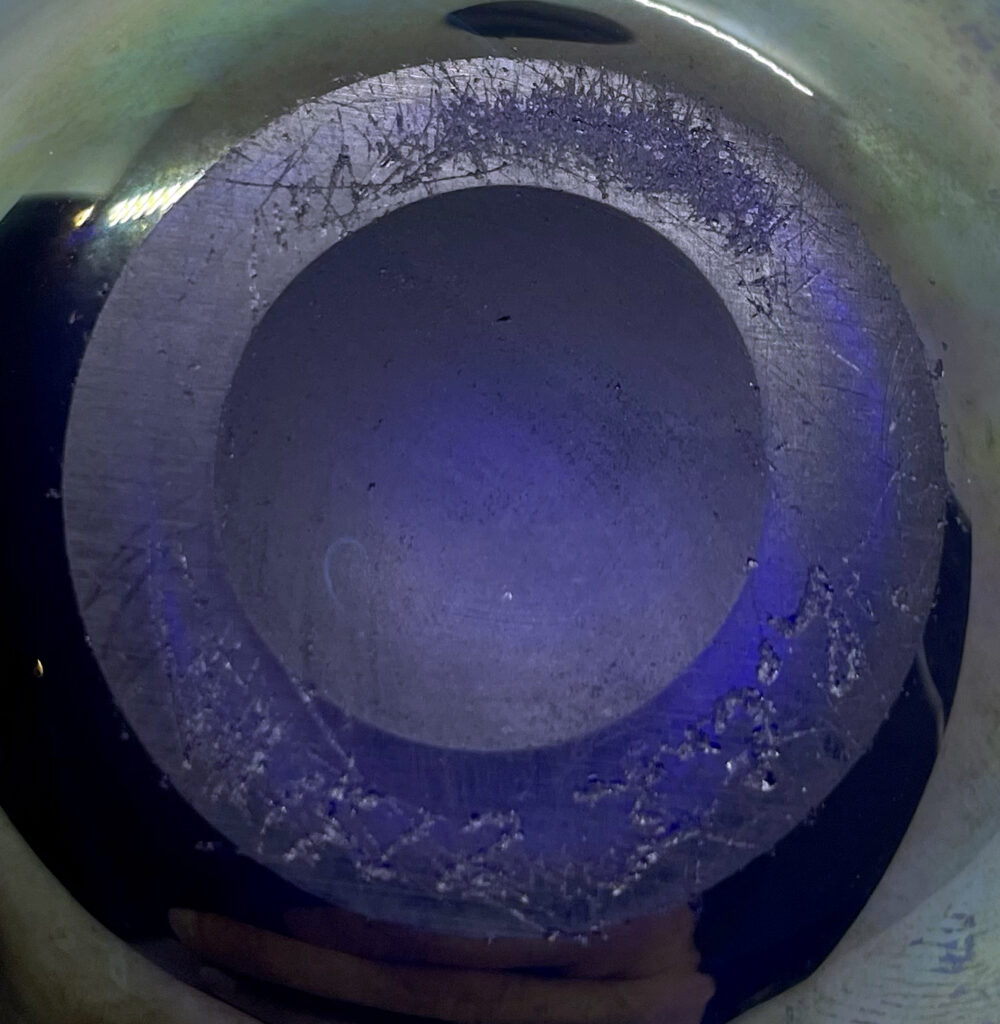
Suspicious Scratches
Opposite the L.C.T. marks on the base is a lozenge-shaped patch of dense scratches that doesn’t match up with wear due to its density compared to the rest of the wear. You can see it at the top of this photo. It was certainly added intentionally by hand…almost as if someone was crossing something out with a pen on paper, to obscure a word…
Bingo!
Let’s look at the other candidates – contemporaries of Tiffany and his work. The overall style is wrong for European makers such as Loetz or Rindskopf, so let’s move back to the America. To cut a long story short, I think that the word obscured in this patch of dense scratches was either ‘Steuben‘ or ‘Aurene‘ – most likely the latter. Aurene was a type of iridescent art glass made by the notable American company Steuben, founded in 1903. It was developed by Frederick Carder (1863-1963) in 1904 and made until 1932. Aurene was made by blowing bodies by hand and spraying them with stannous oxide or lead oxide, and then reheating them to bring out the iridescence. Shapes were largely more ‘regular’ and linear, almost Classical, and they produced a range called ‘Blue Aurene’. Comparing examples online with mine clearly shows that my vase fits visually far more into the Steuben family than the Tiffany family. From the form to the look of the iridescence and more.
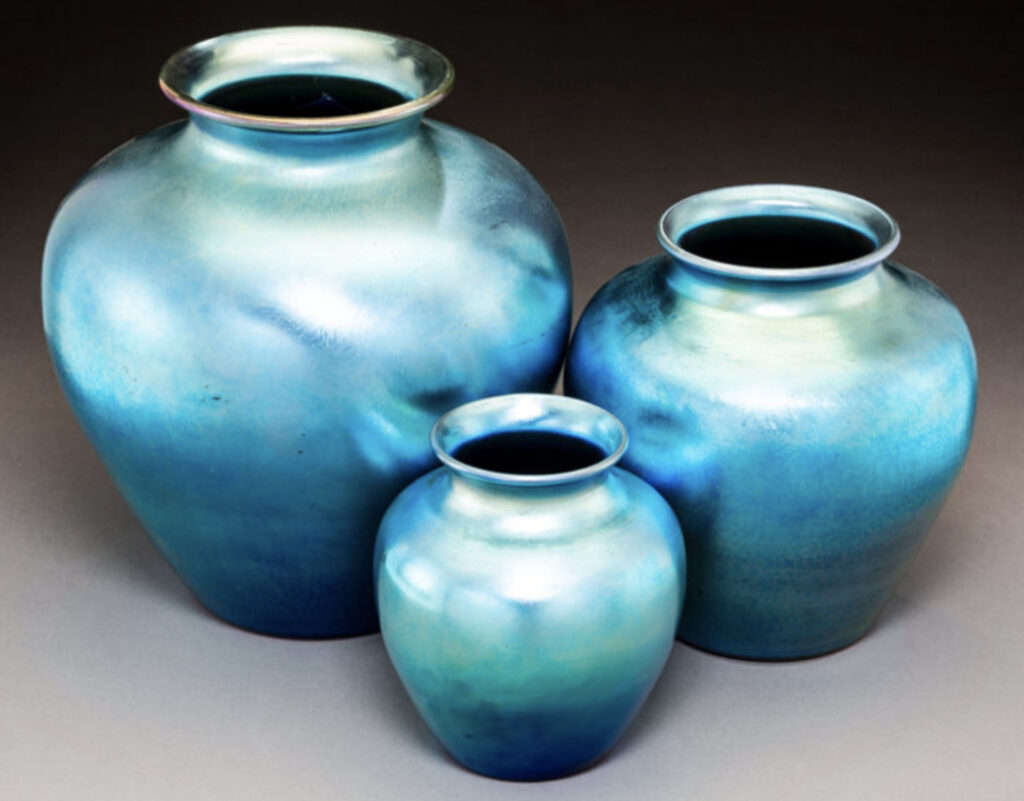
Image by and with thanks to Heritage Auctions.
But Why Add L.C.T?
Quite simply – money. Moolah. Dosh. Although Steuben’s Aurene glass is sought-after and valuable, Tiffany’s is simply worth more. A lot more – maybe ten times more. Tiffany’s glass has always been expensive and vigourously collected – it’s a real luxury, with lamps often fetching millions of pounds. Putting these three magic initials onto the base of an authentic antique iridescent vase, rather than on a piece of 1970s or ’80s studio glass, would fool many more people. As I said, the initials work well with the genuine wear and scratches, indicating that they must have been put on a while ago. Even if that was during the 1980s, that’s forty years ago now – and so forty years of wear…
So Where Does That Leave Me?
In short – happy. My aim to own an authentic piece of American Arts & Crafts iridescent glass is satiated. I’ve loved Steuben almost as much as I’ve loved Tiffany. As we’re on money, what’s it worth? Maybe £120 or so, and Steuben is quite hard to find in the UK. So I’m still quids in, with a great story to boot!
TLDR – never just trust the marks on a piece. Always consider other factors such as shape, colour, style, design and how a piece is made. They should back up what the mark tells you.


